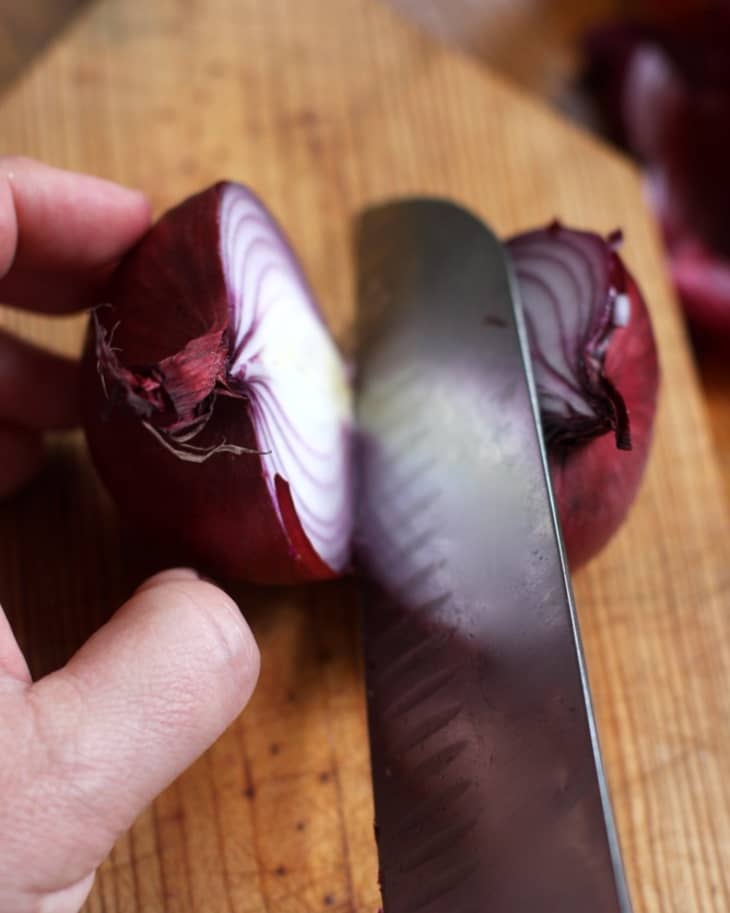How To Chop, Dice, and Mince an Onion
There are very few savory recipes that don’t begin with a chopped onion or that contain minced herbs or garlic. For a new cook, terms like “medium chop” or “small dice” can be confusing. Medium compared to what? How small is small? And how much trouble can you get into if you small chop something when the recipe says to mince?
Sometimes the words chop and dice are used interchangeably, but technically the word ‘dice’ is used for smaller pieces, the word ‘chop’ is used for larger pieces, and the word ‘mince’ means a very small dice.
The Difference Between Chop, Dice, and Mince
Dice can also refer to cutting vegetable into cubes of a specific size, while chop is less precise. In general, chop is more casual and has more leeway, while dice is more specific.
- Large chop: Roughly the size of a nickel
- Medium chop: About half the size of a nickel
- Dice (small chop): About half of medium chop, perhaps a quarter inch to a side
- Mince: Very fine, as small as it can get
From left to right, above: large chop, medium chop, small chop (diced), and minced.
Small chop, or diced.
How Big is a Dice? How Small is a Mince?
How do you know how big or small something is supposed to be? If the recipe writer feels it matters, usually they will also include a measurement, like 3/4″ dice. Again, we see the word dice here to indicate that this is a very specific direction. But if the sizing has some leeway, they will say either large, medium or small chop. Unfortunately, the sizes aren’t standardized so it’s hard to give specific measurements.
Large chop.
What About When a Recipe Calls For “Chunks”?
Most recipes will ask you to either mince, fine (or small) chop or dice, medium chop, or large chop your vegetables, but occasionally they will call for chunks. This is usually reserved for when the vegetables need to be in fairly large pieces, such as for stock. So when you encounter chunk or rough chop in a recipe, you can feel confident simply chopping up your vegetables, keeping the pieces roughly the same size and quite large.
Is The Size Really Important?
The size of the vegetables in a recipe is very important and a good recipe writer has probably taken great care to select the properly sized dice or chop. The size of the vegetables matters for many reasons, but primarily it influences how long they take to cook, the overall texture in the final dish, and taste of the final dish.
A larger piece of bell pepper, for instance, is going to cook more slowly than a smaller piece. It’s going to taste different, as well, and have a different texture and mouthfeel. If the vegetable is pungent (such as garlic or chili) then you usually want smaller pieces, especially if the vegetable isn’t going to be cooked. Raw onions, too, should be sliced thinly or minced finely but cooked onions are sweeter, so they can stand being larger.
Can I Change The Size If I Want?
In general, you should always follow the chopping instructions in a recipe especially if they are very specific. With experience you will begin to get a feel for how big or small to make your chop. Until then, picture the finished dish in your head when prepping the vegetables. Consider if you want the pieces to be big and chewy, or if smaller pieces will fit better. Think about if you would like to bite into a large piece of your vegetable or if it would be better if it were smaller and less obvious.
More Knife Skills Lessons & Tips
Want more smart tutorials for getting things done around the home?
See more How To posts
(Images: Dana Velden)
